冀教版七年级下册英语导学案lesson62导学案
- 格式:doc
- 大小:31.57 KB
- 文档页数:2
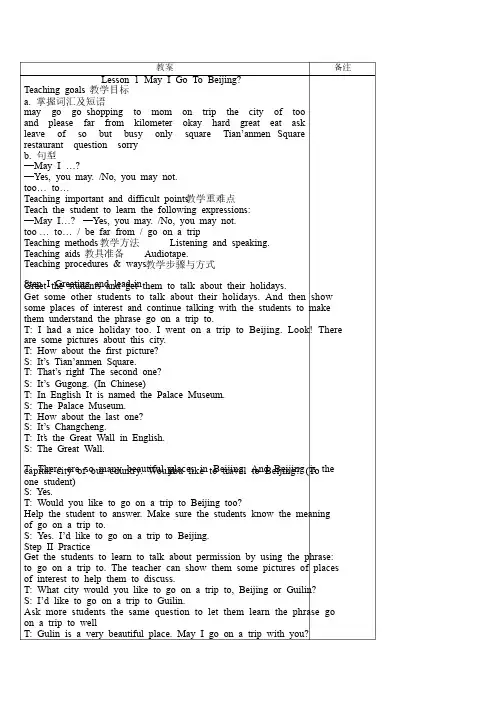
教案教案 备注备注Lesson 1 May I Go To Beijing? Teaching goals 教学目标教学目标a. 掌握词汇及短语掌握词汇及短语 may go go go shopping shopping to mom on trip the city of too and please far from kilometer okay hard great eat ask leave of so but busy only square Tian’anmen Square restaurant question sorry b. 句型句型 —May I …? —Yes, you may. /No, you may not. t oo… to… Teaching important and difficult points 教学重难点教学重难点 Teach the student to learn the following expressions: —May I…? —Yes, you may. /No, you may not. too … to … / be far from / go on a trip Teaching methods 教学方法教学方法 Listening and speaking. Teaching aids 教具准备教具准备 Audiotape. Teaching procedures & ways 教学步骤与方式教学步骤与方式教学步骤与方式 Step I Greeting and lead-in Greet the students and get them to talk about their holidays. Get some other students to talk about their holidays. And then show some places of interest and continue talking with the students to make them understand the phrase go on a trip to. T: I had a nice holiday too. I went on a trip to Beijing. Look! There are some pictures about this city. T: How about the first picture? S: It’s Tian’anmen Square. T: That’s right ! The second one? ! The second one? S: It’s Gugong. (In Chinese) T: In English It is named the Palace Museum. S: The Palace Museum. T: How about the last one? S: It’s Changcheng. T: It’s the Great Wall in English. S: The Great Wall. T: There are so many beautiful places in Beijing. And Beijing is the capital city of our country. Would you like to travel to Beijing? (To one student) S: Y es. T: Would you like to go on a trip to Beijing too? Help the student to answer. Make sure the students know the meaning of go on a trip to. S: Yes. I’d like to go on a trip to Beijing. Step II Practice Get the students to learn to talk about permission by using the phrase: to go on a trip to. The teacher can show them some pictures of places of interest to help them to discuss. T: What city would you like to go on a trip to, Beijing or Guilin? S: I’d like to go on a trip to Guilin. Ask more students the same question to let them learn the phrase go on a trip to well T: Gulin is a very beautiful place. May I go on a trip with you? Help the student to answer: Yes, you may. Or No, you may not. Explain the meaning in Chinese if necessary. S: Yes, you may. T: T: (To (To (To another another another student) student) student) I I I have have have no no no money money money to to to go go go on on on a a a trip trip trip to to to Guilin. Guilin. May I borrow some money? S: No, you may not. Step III Text learning Get the students to learn the text. Listening Get the students to listen to the tape and answer a question. And then get them to repeat after the tape. T: T: Li Li Li Ming Ming Ming wants wants wants to to to go go go on on on a a a trip trip trip to to to Beijing. Beijing. Beijing. Listen Listen Listen to to to the the the tape tape carefully. Does Li Ming’s mother go on a trip to Beijing too? S: (After listening) Yes. Paraphrasing Explain the following sentences. Notes: 1. You are too young to go, Ling Ming. It means Li Ming is too young. If he goes to Beijing, he cannot take care of himself. 2. Beijing is far from our city. It means Beijing is not near Shijiazhuang. 3. You work hard in school. It means Li Ming studies hard. Practice Get the students to read and act out the dialogue in pairs. And then ask them to work in pairs and make up their own dialogues using go on a trip to, too… to…, be far from and May I…? They can talk from the following aspects: 1.Where you want to go for a trip; 2. Why you cannot / can go there; 3.Who will go with you. Walk around to give them a hand if necessary. Sample dialogue: S1: May I go on a trip to New York, mom? S2: No, you may not. Now York is too far to go. S1: Dad? S3: No, you are too young to go. You can go to a city near our home. S1: May I go on a trip to Lasa? S3: No, you may not. It’s far from our city.S1: May I go on a trip to Beijing? S2 and S3: Yes, you may. We will go to Beijing too. Step IV Homework Finish the exercises in Activity book. Practice the dialogue in pairs. Preview Lesson 2 Lesson 2 May I Invite Danny and Jenny? Teaching goals 教学目标教学目标 a. 掌握词汇掌握词汇want come hello with who when do leave for arrive. b. 认知词汇认知词汇 invite them Mrs. call oh wonderful invitation bye hooray c. 句型句型 When do you leave for …? / When do you arrive in / at …? —May I speak with / to …? —This is … (speaking). Who’s that?Teaching important and difficult points 教学重难点教学重难点Grasp the expressions of making phone calls. Teaching methods 教学方法教学方法 Listening and speaking. Teaching aids 教具准备教具准备 Audiotape and pictures. Teaching procedures & ways 教学过程与方法教学过程与方法教学过程与方法 Step I Lead-in and speaking T: Good morning, class. S: Good morning, Miss /Mr. /Ms. … T: We know that Li Ming will go on a trip to… S: Beijing! T: Do you want to go to Beijing? Why or why not? Help Help the the the students students students to to to answer answer answer these these these questions questions questions from from from the the the following following aspects: Affirmative: 1. have fun; 2. learn a lot that can not be found in the text book; 3. make other friends … Negative: 1. Beijing is too far away; 2. too young to go; 3. … T: If you can go to Beijing, who do you want to take with you? Why? S: I may go with my parents. They can take care of me, and share the happiness together. S: I may go with my friends. We have the same interest and can have a lot of fun. S: I may go with my little brother. I can learn to take care of him and learn a lot. T: Good! Wish you a good trip to Beijing. Step II Reading Fast reading Get the students to scan the dialogue to look for the expressions about making phone calls in English. T: Li Ming wants to go to Beijng, do you know who does he want to take to Beijng? Now, look through the text and show me the answer. S: Jenny and Danny. T: That ’s it! But where are Jenny and Danny? S: They live in Canada. T: So how can Li Ming invite them? S: Make a phone call. T: Good! Please read the dialogue in Lesson 2 silently and try to find out ways to make a phone call. After the students finish reading, summarize the following patterns. —Hello. May I speak with / to …?—Yes, this is…. Who’s that?—This is …T: Great! Careful reading Get the students to learn about how to invite somebody on the phone. 1. Paraphrasing Make a dialogue to help the students understand the phrases leave for and arrive at / in. T: Hello. May I speak to Mary? S: Hello. This is Mary. Who is that? T: This is … I’m going on a trip to Beijing. Would you like to go with me? S: Y es. T: Let’s meet at the school gate at 9:00 on Friday. OK? S: OK. Draw Draw the the the school school school gate gate gate and and and Beijing Beijing Beijing West West Railway Railway Station Station Station on on on the the blackboard and let the student come to the front of the classroom to act act with with with you. you. you. The The The two two two walk walk walk from from from the the the school school school gate gate gate in in in the the the picture picture picture to to Beijing Railway Station in the picture. T: We are leaving our school. We are leaving for Beijing. Now we are arriving arriving in in in Beijing, Beijing, Beijing, arriving arriving arriving at at at Beijing Beijing Beijing West West West Railway Railway Railway Station. Station. Station. W W e usually arrive at a small place; and arrive in a big place. Got it? Write Write the the the phrases phrases phrases on on on the the the blackboard, blackboard, blackboard, explain explain explain them them them and and and lead lead lead the the students to read them. 2. Reading Get the students to read the dialogue and answer the questions given. After that ask them to listen and repeat, and then act out the dialogue. Who does Li Ming want to take to Beijing? (He wants to take Danny and Jenny to Beijing.) Can Jenny come? (Yes, she can.) When do Li Ming and his mother leave for Beijing? (They leave on February 1 in the morning.) When When do do do they they they arrive arrive arrive in in in Beijing? Beijing? Beijing? (They (They (They arrive arrive arrive in in in Beijing Beijing Beijing in in in the the afternoon on February 1.) Step III Presentation Let Let the the the students students students work work work in in in pairs pairs pairs to to to make make make up up up similar similar similar dialogues dialogues dialogues to to practice the expressions of making a phone call. They can talk from the following aspects: 1. Where you want to go for a trip; 2. Who you want to invite to have a trip; 3. When you leave. Ask some pairs to act out their dialogues. Step IV Homework Finish off the exercise in Activity book. Preview Lesson 3. Lesson 3 How Far Is Beijing? Teaching goals 教学目标教学目标 a. 掌握词汇掌握词汇 me about here him there say thousand b. 认知词汇认知词汇 dinosaur think visit Edmonton laugh worry be partner practice c. 句型句型 How far is it from … to …? It It’’s about … kilometers. Teaching important and difficult points 教学重难点教学重难点 Grasp the expressions of talking about distance. How to express numbers from one hundred to ten thousand. Teaching methods 教学方法教学方法 Listening, and speaking. Teaching aids 教具准备教具准备 Audiotape and maps. Teaching procedures & ways 教学过程与方式教学过程与方式教学过程与方式 Step I Revision Greeting T: How are you doing? S: We are fine. Revision Help the students review Lessons 1 & 2 by asking questions. Why does Li Ming want to go on a trip to Beijing? Because Beijing is the capital city of our country and it’s not far from his city, Shijiazhuang. Why does Li Ming’s mother let Li Ming go on a trip to Beijing? Because Because Li Li Li Ming Ming Ming is is is not not not too too too busy, busy, Beijing Beijing is is is not not not very very very far far far from from Shijiazhuang, Li Ming is a good student and works hard in school. What can Li Ming do in Beijing? He can go shopping, eat in restaurants and go to a hotel. Step II Lead-in Show the students the map of China and the world map to help them to talk about distance. Lead the students to read the numbers in this lesson. Step III Text learning Reading Get Get the the the students students students to to to read read read the the the text text text again again again and and and answer answer answer the the the following following questions. T: Now please read the dialogue and find out the answer to the two questions: Why is Mrs. Dinosaur worried? And can Danny go? S: Because Canada is too far from China. S: Yes, he can. T: That’s right. Listening Then get the students to listen to and repeat after the tape. Later, ask them to act out the dialogue. Step IV Get the students to talk about distance. Speaking Write How far is it from … to …? / It’s about… kilometers and some numbers on the Bb to let the students practice talking about distance. Explain the usage of hundred and thousand. Notes: Notes: hundred, hundred, hundred, thousand thousand 前面有具体数字时,不要加s; 一般情况下,百位与个位之间用and (也可以不用and )十位和个位之间可以用连字符,也可以不用。

玉门三中 七年级英语(下)导学案 主备人 张 莉 编号 NO.6 学生姓名: 班级: 等级 时间把规范修炼成一种习惯,把认真内化成一种性格课题lesson6 Li Ming Packs His Suitcase【Learning aims:】1、New words: pack, suitcase, jacket, more, forget, teddy bear, chant2、Sentences: May I help you?Do you want sth......?【Important and difficult points:】 学会生活用品用语。
【知识链接与探究】:1. What are you doing, Li Ming?◎此句是一个含有现在进行时的句子,现在进行时的结构是:主语+be(am, is, are)+v.ing ,它表示现在或此刻正在发生或进行的动作。
Eg :I'm writing a letter to Jim. 我正在给吉姆写信。
She is singing a ABC song. 她正在唱一首ABC 歌。
They are playing football. 他们正在踢足球。
2.May I help you?◎help 意为“帮助”常用于结构help (sb.) (to) do sth.帮助某人做某事 Eg:I will help my mother (to) clean the room. 3.One pair! You need more socks! ◎need 的用法:本句中need 为实义动词,变否定句和疑问句时都需加助动词,其后面可跟名词,代词或不定时作宾语,即need to do sth.或need sth.Eg: We need to do our homework every day.Do you need some water? 掌握:need to do sth. 需要做某事 4.Don't forget your teddy bear.◎ forget doing sth. :忘记曾做过某事,强调此事已做过,但又忘记了。
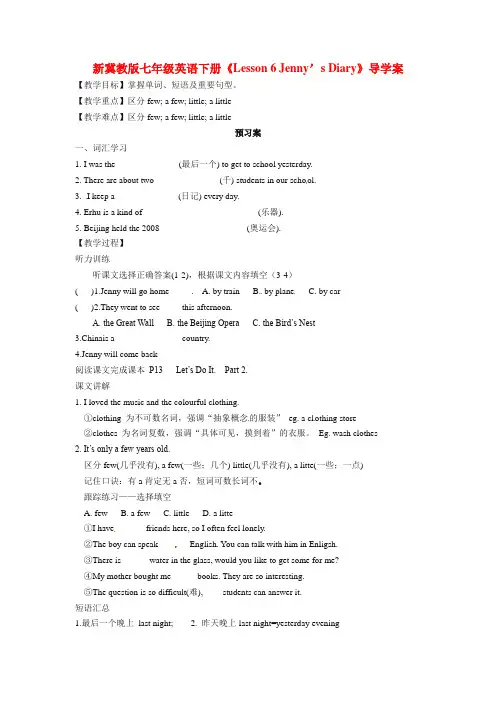
新冀教版七年级英语下册《Lesson 6 Jenny’s Diary》导学案【教学目标】掌握单词、短语及重要句型。
【教学重点】区分few; a few; little; a little【教学难点】区分few; a few; little; a little预习案一、词汇学习1. I was the ______________(最后一个) to get to school yesterday.2. There are about two_______________(千) students in our scho ol.3. I keep a ______________(日记) every day.4. Erhu is a kind of __________________________(乐器).5. Beijing held the 2008____________________(奥运会).【教学过程】听力训练听课文选择正确答案(1-2),根据课文内容填空(3-4)( )1.Jenny will go home_____. A. by train B. by plane C. by car( )2.They went to see_____this afternoon.A. the Great WallB. the Beijing OperaC. the Bird’s Nest3.Chinais a _______________country.4.Jenny will come back ________________阅读课文完成课本P13 Let’s Do It. Part 2.课文讲解1. I loved the music and the colourful clothing.①clothing 为不可数名词,强调“抽象概念的服装”eg. a clothing store②clothes 为名词复数,强调“具体可见,摸到着”的衣服。
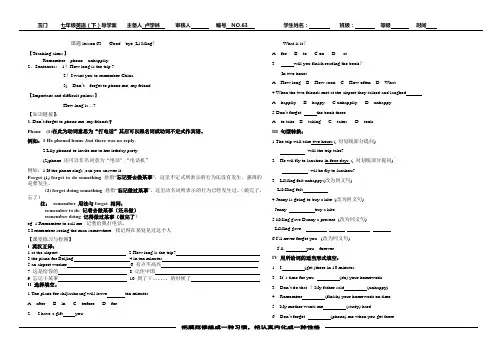
玉门 七年级英语(下)导学案 主备人 卢学林 审核人 编号 NO.63 学生姓名: 班级: 等级 时间把规范修炼成一种习惯,把认真内化成一种性格课题lesson 63 Good---bye ,Li Ming !【Teaching aims:】Remember phone unhappily 2、Sentences: 1)How long is the trip ?2)I want you to remember China. 3) Don ’t forget to phone me, my friend.【Important and difficult points:】How long is …?【知识链接】:1. Don ’t forget to phone me, my friends ?Phone (1)在此为动词意思为“打电话”其后可以跟名词或动词不定式作宾语。
例如:1 He phoned home ,but there was no reply. 2 Lily phoned to invite me to her irthday party. (2)phone 还可以作名词意为“电话” ,“电话机”例如:1 If the phone rings ,can you answer it.Forget (1) forget to do something 意指“忘记要去做某事”,这里不定式所表示的行为还没有发生,强调的是要发生。
(2) forget doing something 意指“忘记做过某事”,这里动名词所表示的行为已经发生过。
(做完了,忘了)注: remember 用法与forget 相同:remember to do 记着去做某事(还未做) remember doing 记得做过某事(做完了)eg. 1 Remember to call me. 记着给我打电话。
2 I remember seeing the man somewhere. 我记得在某处见过这个人【课堂练习与检测】 I 英汉互译:1 at the airport2 How long is the trip?3 the plane for Beijing4 in ten minutes5 an airport worker6 有点不高兴7 这是给你的8 记住中国9 忘记干某事 10 到了干。
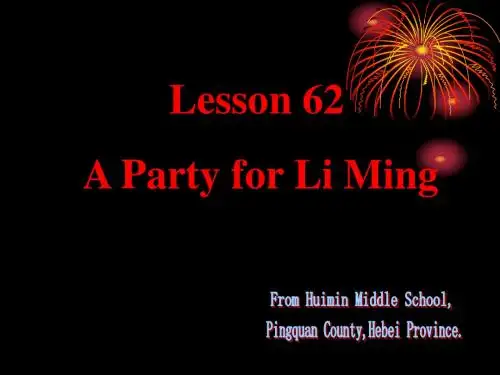
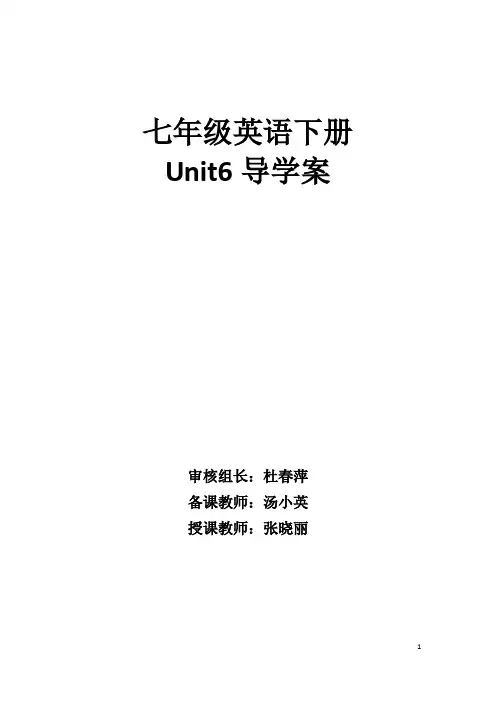
七年级英语下册Unit6导学案审核组长:杜春萍备课教师:汤小英授课教师:张晓丽Lesson31 What Strange Weather ! Teaching aimsWordsstrange, notice, wild, wake, surprised, become, dark, ski, snowball Phrases :wake up, go away, go skiing, good work, have snowball fights Sentence structures:过程与方法:自主学习、合作探究、讨论练习Teaching important point:初步认识感叹句Teaching difficult point:能用英语简单的描述四季景色。
Something about students:Teaching steps:Step1.Check preview翻译下面的单词及短语:introduce______ win first place ________ go away _______________ play chess ________ try to ______ look forward to_____ Step2.Reseach1.Listening: Listen to the tape and finish off Let’s Do It No.12.Reading: Read the dialogue and finish off Let’s Do It No.2Step3.Work in groupsDiscussing:1.How to use “will”1.How to use “May I……2.Show your work :Choose some groups to present their work ,thenshow their questionsStep4.Summary1. wake v. 醒◆I woke up this morning and I was surprised!我今天早上醒来大吃一惊!◆My mother wakes me up at 6: 00 every morning.我母亲每天早上六点钟把我叫醒。
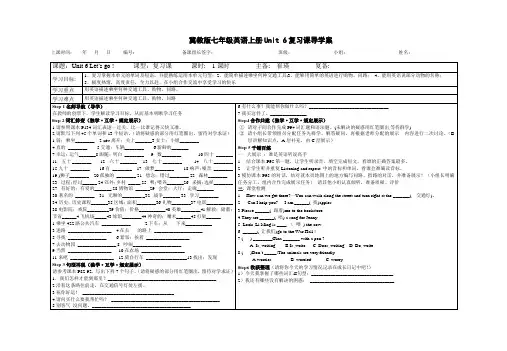
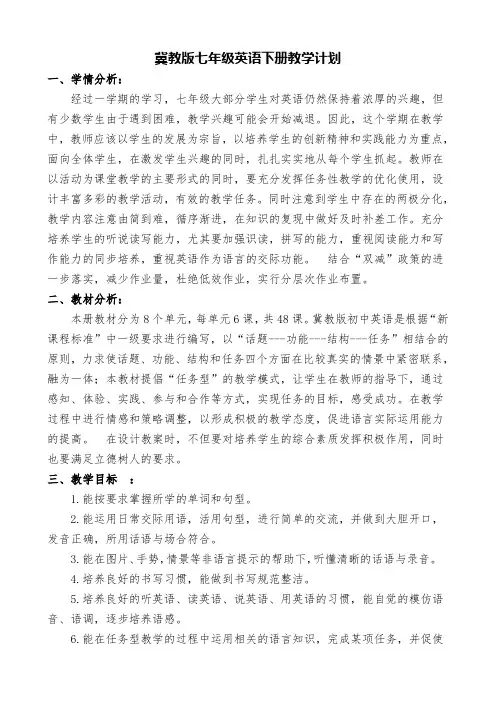
冀教版七年级英语下册教学计划一、学情分析:经过一学期的学习,七年级大部分学生对英语仍然保持着浓厚的兴趣,但有少数学生由于遇到困难,教学兴趣可能会开始减退。
因此,这个学期在教学中,教师应该以学生的发展为宗旨,以培养学生的创新精神和实践能力为重点,面向全体学生,在激发学生兴趣的同时,扎扎实实地从每个学生抓起。
教师在以活动为课堂教学的主要形式的同时,要充分发挥任务性教学的优化使用,设计丰富多彩的教学活动,有效的教学任务。
同时注意到学生中存在的两极分化,教学内容注意由简到难,循序渐进,在知识的复现中做好及时补差工作。
充分培养学生的听说读写能力,尤其要加强识读,拼写的能力,重视阅读能力和写作能力的同步培养,重视英语作为语言的交际功能。
结合“双减”政策的进一步落实,减少作业量,杜绝低效作业,实行分层次作业布置。
二、教材分析:本册教材分为8个单元,每单元6课,共48课。
冀教版初中英语是根据“新课程标准”中一级要求进行编写,以“话题---功能---结构---任务”相结合的原则,力求使话题、功能、结构和任务四个方面在比较真实的情景中紧密联系,融为一体;本教材提倡“任务型”的教学模式,让学生在教师的指导下,通过感知、体验、实践、参与和合作等方式,实现任务的目标,感受成功。
在教学过程中进行情感和策略调整,以形成积极的教学态度,促进语言实际运用能力的提高。
在设计教案时,不但要对培养学生的综合素质发挥积极作用,同时也要满足立德树人的要求。
三、教学目标:1.能按要求掌握所学的单词和句型。
2.能运用日常交际用语,活用句型,进行简单的交流,并做到大胆开口,发音正确,所用话语与场合符合。
3.能在图片、手势,情景等非语言提示的帮助下,听懂清晰的话语与录音。
4.培养良好的书写习惯,能做到书写规范整洁。
5.培养良好的听英语、读英语、说英语、用英语的习惯,能自觉的模仿语音、语调,逐步培养语感。
6.能在任务型教学的过程中运用相关的语言知识,完成某项任务,并促使语言能力的提高。
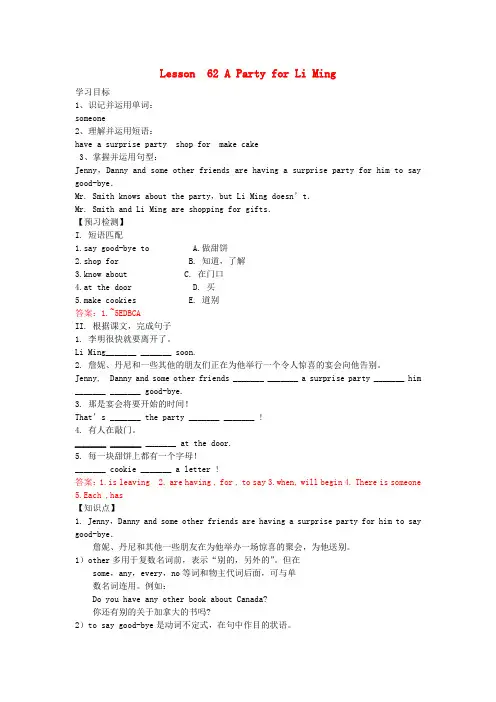
Lesson 62 A Party for Li Ming学习目标1、识记并运用单词:someone2、理解并运用短语:have a surprise party shop for make cake3、掌握并运用句型:Jenny,Danny and some other friends are having a surprise party for him to say good-bye.Mr. Smith knows about the party,but Li Ming doesn’t.Mr. Smith and Li Ming are shopping for gifts.【预习检测】I. 短语匹配1.say good-bye to A.做甜饼2.shop for B. 知道,了解3.know about C. 在门口4.at the door D. 买5.make cookies E. 道别答案:1.~5EDBCAII. 根据课文,完成句子1. 李明很快就要离开了。
Li Ming_______ _______ soon.2. 詹妮、丹尼和一些其他的朋友们正在为他举行一个令人惊喜的宴会向他告别。
Jenny, Danny and some other friends _______ _______ a surprise party _______ him _______ _______ good-bye.3. 那是宴会将要开始的时间!That’s _______ the party _______ _______ !4. 有人在敲门。
_______ _______ _______ at the door.5. 每一块甜饼上都有一个字母!_______ cookie _______ a letter !答案:1.is leaving 2. are having , for , to say 3.when, will begin 4. There is someone 5.Each ,has【知识点】1. Jenny,Danny and some other friends are having a surprise party for him to say good-bye.詹妮、丹尼和其他一些朋友在为他举办一场惊喜的聚会,为他送别。
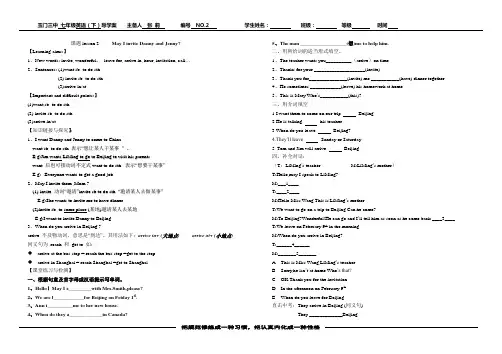
玉门三中 七年级英语(下)导学案 主备人 张 莉 编号 NO.2 学生姓名: 班级: 等级 时间把规范修炼成一种习惯,把认真内化成一种性格课题lesson 2 May I invite Danny and Jenny?【Learning aims:】1、New words: invite, wonderful , leave for, arrive in, hour, invitation, call …2、Sentences: (1)want sb. to do sth.(2) invite sb. to do sth. (3)arrive in/at【Important and difficult points:】 (1)want sb. to do sth. (2) invite sb. to do sth. (3)arrive in/at 【知识链接与探究】:1、I w a n t D a n n y a n d J e n n y t o c o m e t o C h i n a . w a n t s b . t o d o s t h .表示“想让某人干某事 ” 。
E .g :J i m w a n t s L i M i n g t o g o t o B e i j i n g t o v i s i t h i s p a r e n t s . w a n t 后也可接动词不定式w a n t t o d o s t h . 表示“想要干某事” E .g :E v e r y o n e w a n t s t o g e t a g o o d j o b . 2、M a y I i n v i t e t h e m ,M o m ?(1) i n v i t e 动词“邀请”i n v i t e s b .t o d o s t h .“邀请某人去做某事”E .g :S h e w a n t s t o i n v i t e m e t o h a v e d i n n e r . (2)i n v i t e s b . t o s o m e p l a c e (某地)邀请某人去某地 E .g :I w a n t t o i n v i t e D a n n y t o B e i j i n g . 3、When do you arrive in Beijing ?arrive 不及物动词,意思是“到达”。

Lesson 1 May I Go to Beijing学习目标1掌握重点短语词汇句型trip may square May I /we…?2 通过小组研讨,对学过的知识进行演示,培养学生的肢体语言的表达能力。
学习重点学会运用情态动词May I /we…? Yes, you may. No ,you may not 学习难点学会运用情态动词在不同人称中的用法学习方法小组讨论学习过程及内容教师学生活动课前预习一:重点知识点讲解1 Go on a trip to A 去A地旅行.2 May 表示请求允许,无人称和数的变化.3 Too+ 形/副to do sth 表示否定的含义,是太… 不能干.4 Be busy doing sth(动名词)是忙于做某事,就等于be busy with sth (名词)5 A be far from (away) A 离B远6 Two hundred / thousand / million/ billion 两百/千/百万/亿Hundreds/ thousands / millions/ billions of 成百/千/百万/亿7 From A to B 从A 到B .8 Work hard at A 努力干A(介+ doing )9 Too many +可数名词的复数。
Too much +不可数名词10 live in + 大地方(城市)Live at + 小地方(农村)二:重点知识点巩固练习1 He may _____(go) home now . ————————————————一(一般疑问句)—————————————————(否定句)2 He wants ____(go)____a trip ___Beijing.3 He is too young _____(go) to school.He is too old to ____(climb ) the tree .4 The coat is ______(thousand )of yuan .5 We go to school ____Monday(介词)6 Do they go to school _____Monday ____Friday (介)7 Mary is working hard ____ English .8 Let us go ______(boat).9 Let us go to the park______(play).10 There are too______(much/many) people in the .Park..Lesson 2:May I invite Danny and Jenny学习目标1掌握重点短语词汇句型2 通过小组研讨,对学过的知识进行演示,培养学生的学习语言的表达能力。
Unit 8 Li Ming Goes Home第六课时Lesson 62 A Party for Li Ming◆课程目标导航Teaching content:1. Learn the new words.2. Master the dialogue of this lesson.3. Learn to use the model: “Li Ming is leaving soon. That’s when the party begins.”【教学目标】Teaching goals:1. Keep the new words in mind: someone, each2. Master the passage and retell the story.3. Master the patterns of this lesson.【教学重点】Key points:1. Learn to retell a story.2. Master the usage of some key sentences.【教学难点】Difficult points:Retell the whole passage.◆教学情景导入1. Greetings.2. Retell the story in Lesson61.3. Lead in by showing the s tudents real objects. Such as cakes, cookies, ice-cream. Ask them to remember the w ords.◆教学过程设计Step 1 Presentation1. Use real objects to introduce cake, cookies and ice-cream.2. Ask a volunteer to go out of the classroom. Hide something in his/ her desk.Teacher: Let’s give _____ a surprise. This flag is a surprise for ______.Ask the volunteer to return to the classroom.I put something in your desk. Does _____ know what’s in his/ her desk, class?Students: No.Teacher: Very good! _____ doesn’t know what I put in his / her desk. It’s a surprise! A surprise.Students: A surprise.Teacher: Yes, there is a surprise in your desk. Can you find it?Volunteer: Yes!Teacher: What is it?Volunteer: A flag.Teacher: Good. Let’s see what surprise does Li Ming have in the passage.Step 2: Listen and readPlay the audiotape as the students follow along in their student books. Then a sk the students read after.Step 3: Read and retell1. Ask some students to read in passage in front of the class.2. Ask volunteers to retell the story.Step 4 Practice1. Talk about the pictures in this lesson.Teacher: What are the children going to do?Students: They are going to have a surprise party.Teacher: Why are they going to have a surprise party?Students: Because Li Ming is leaving.Teacher: Does Li Ming know it?Students: No.…2. Practise in pairs.Unit 8 Li Ming Goes HomeLesson 62 A Party for Li MingⅠ. New words:someone, eachⅡ. Important sentences:1. Li Ming is leaving soon.is leaving = is going to leave2. That’s when the party begins.when = the time that3. There’s someone at the door.4. At 4:00, Li Ming arrives with Mr. Smith.arrive — reach — g et toWhen do you usually get to school?◆作业1. Finish the exercises in the activity book.2. Recite the dialogue.3. Make dialogue by using the pictures below.A: What will you give him/ her for a surprise?B: I will give him/ her ______.课后巩固练习单项选择。
2012—2013学年度第二学期七年级英语教学进度表冀教版七年级下册英语教材分析一、整体分析《英语》七年级下册共8个单元,全书采取任务型语言教学模式,融汇话题、交际功能和语言结构,形成了一套循序渐进的生活化的学习程序。
教材以A Trip to the Silk Road 为第一个主题,阐述了Jenny, Danny, 李明和他们的同学一起沿丝绸之路且游且学,了解了很多中国的历史和文化。
除此之外,还涉猎到School Life, After School Activities, Seasons, Sports and Good Health 和Summer Holiday 等话题。
其中每个单元都列出明确的语言目标,主要的功能项和语法结构,需要掌握的基本词汇,并且设有复习题目。
该教材的一个亮点就是每节课后还有self-check 部分,供学生检测本课所学语言知识之用。
它采用"语言的输入——学生的消化吸收——学生的语言输出"为主线编排,并采用听、说、读、写,自我检测等手段,有效提高了语言学习者的学习效率,体现了以学生为主体的思想。
二、教学重难点1.Talking about distance. Using "will"and numerals.2. Regular and irregular verbs. Simple past tense.3.Talking about school. Using adverbs: always, often, usually, sometimes, never.4.Talking about weekend activities and personal interests. Using "be going to ".5.Reflexive pronouns: myself, yourself.6.Talking about sensons and activities. Exclamatory sentences.7.Talking about habbits, exercise and good health. Using " there be ".8.Talking about plans. Modal verb: can.三、教学措施1、加强词汇教学。
第六十二课 Lesson Sixty-two_七年级英语教案第六十二课Lesson Sixty-two一、教学内容复习can的用法、表示位置(空间)的介词短语及句型、物主代词和有关句型以及时刻表示法。
二、教具教具钟等。
三、课堂教学设计1.值日生报告。
2.打开书,指导学生看图,两人一组用课本提供的问题进行问答练习,并要求学生用笔头形式将答案写出。
请几位同学朗读自己的答案。
3.学生两人一组,就课文第二部分的插图进行问答练习。
教师可先与一位同学做示范。
小组练习后,请几组同学给出自己的答案。
4.指导学生做练习册习题。
要求学生用笔头形式答出。
5.布置作业完成练习册习题。
Lesson 89 教学设计示例(一)一、教学内容1.复习表示请求、征求意见用语。
2.复习可数名词的复数形式和不可数名词的用法。
二、教具录音机;与本课替换词汇有关的图片。
三、课堂教学设计1.值日生报告。
2.教师出示有关食物等图片,复习这些词汇(可借用第73、74、75课的插图)。
3.放课文录音。
教师先板书问题:How many bottles of orange would Mr Green like?放录音一遍,学生回答黑板上的问题。
再放录音,学生跟读两遍。
4.学生两人一组,练习本课第2部分Make an interview。
提示学生就双方的实际情况进行问答。
5.利用107页上所列出表格,教师可允许学生就周围同学的相关情况进行提问,并做一些记录。
数分钟后,教师请几位同学介绍自己周围的同学情况。
6.布置作业1)完成练习册习题;2)温习174页有关名词的内容。
Lesson 89 教学设计示例(二)●Teaching Objectives复习关于饮食的单词、交际用语及一些常用短语。
●Main PointsDo you have …? Could I have …? I like …●Difficult Points应用所学知识,来订餐、点餐或叙述个人的饮食习惯.● Teaching Aidsa tape-recorder, cards, pictures, slide projector● Teaching ProcedureStep 1 RevisionFree talk (ask and answer some questions) .Step 2 Presentation通过让学生讨论“怎样邀请别人用餐”导入新课。
冀教版七年级英语下册导学案Unit 1教材冀教版英语七年级下册授课时间主讲人授课班级课题Lesson 6 Jenny’s Diary课时安排课型教学目标1. Remember the new words and phrases, master the meaning of text.2. Make sure the Ss can learn to describe a place of interests you have visited.3. Show some interesting place that you know.教学重点Words and phrases, Learn to let student remember what they saw did on the trip.教学难点1. Learn the differences between a few and a little.2. How to help the students understand material.教学方法 Listening, speaking, reading, writing and practice.教学资源 Electronic whiteboard, Multimedia courseware, A recorder,教学步骤教师活动学生活动调整与思考教学过程设计Step 1 Analysis of the student.Let the students write words in the note, then check theanswer.Step 2 Lead in.1. Greet the students in English and make sure they canresponse correctly.Do the duty report: a student on duty can say whateverhe/she likes to say.2.Ask some Ss talk about the following questions:1.When did Jenny love about the Beijing opera?2.Where did the group go yesterday afternoon?3.What event was held at the Bird's Nest in 2008?4. What new instrument did Jenny learn about?Step 3. New lesson.No. 1 Prepare lessons before class.Teach the new words and phrases. Make sure theSs can read it correctly.No. 2 Text: Give them some time to read the textthemselves. Then let them act out the dialogue ingroups. Correct their pronunciation whennecessary. At last, the teacher explain the text inChinese, make sure the Ss can understand themeaning of text.No. 3 Ask the Ss finish the following questions:1.When did Jenny love about the Beijing opera?2.Where did the group go yesterday afternoon?Ask onestudent to readthe title ofLesson 6Ask thestudents just tolisten .Let the studentsdo Let’s Do it1Let the studentsdo Let’s Do it2Ask somestudents andanswer in pairs.教学过程设计课堂检测3.What event was held at the Bird's Nest in 2008?4. What new instrument did Jenny learn about?And then make the Ss answer the above questionsin pairs.No. 4 Some important phrases and sentences:a few, a little, thousands of ,diary, last,few, thousand, someday ,nest building,hold Olympics clothing instrument,a place of interests you have visited.No. 5 Review the grammar:1. The present tense2. thousands of3. a few/a little4. lastNo. 6 Complete Let’s Do it!Step 4. Play the tape for the Ss to follow.Make the Ss listen the text, then let them read follow thetape.Step 5.Summary.Sum up the text what we learned, the new words,phrases, and sentences.Sum up the grammar.Step 6 课堂检测一、选择填空。
七年级下英语导学案Unit6 SectionA(2a-2d)第二课时各位读友大家好,此文档由网络收集而来,欢迎您下载,谢谢七年级下册英语导学案Unit6SectionA第二课时七年级下册英语导学案课题:Unit6I’课型:听力课学习目标:1.初步了解现在进行时态的构成以及现在分词的变化规律。
2.能听懂本课相应的材料。
3.能简单理解和运用现在进行时态的,并能用现在进行时描述正在发生的动作。
重点:初步了解英文电话交际的特征,掌握一些电话交际用语。
难点:现在进行时态的用法。
导学过程:一.激趣导入:提问:句子whatareyourdoing?whatisshe/hedoing?导入新课。
二.明示学习目标三.自学互动,适时点拨自学互动(一)认读并书写本课单词任务1.自个认读并书写本课单词任务2.个人竞赛读本课单词自学互动(二):听录音任务一:1.听录音,2a听录音将问题和答案配对。
2.再听一遍录音,自己核实答案。
3.小组相互核对答案,检查所听结果。
任务二:听录音1、2b听录音并完成对话内容。
2.再听一遍录音,自己核实答案。
3.小组相互核对答案,检查所听结果。
动后点评价:老师检查学生听力情况,并及时评价和适时点拨自学互动:结伴练习2c的对话。
任务三:1.要求学生边读对话边翻译。
2.学生质疑,师生共同解惑。
3.教师领读或听录音带跟读课文。
4.学生角色表演2d的对话。
学生自愿或派代表进行对话,老师评价及时点评知识点拨:现在进行时态的构成及运用。
主语+be++其他what+be+主语++其他?疑问句:Be+主语++其他?四:课堂测评一.翻译下列句子:我在做作业。
学生们在听老师讲课。
在看报子。
Laura正在做什么?她在卖东西。
She二.选择题:()1.各位读友大家好,此文档由网络收集而来,欢迎您下载,谢谢。
学校: XXX 备课组: 八年级英语组 主备人:XXX 审核: XXX 年级: 班级: 组名: 姓名:1 1Lesson 62 Take Short Showers!共8课时,第6课时学习目标:1. 重点词组短语:make into pick up2. 识别的词汇:can 罐头3. 重点:get+名词/代词+过去分词结构 一、 自主预习Answer the following questions: 1.What does Liu Yan do to save water?2.What does she think of the cars?3.How does she go to school?二、预习自测1. The garbage can be r2. Don't w about it, it will be fine.3. Please t out one pen from your bag.4. My bike will be r5. Don't t away rubbish everywhere.6. We should p and love our environment.7. Garbage is a t of pollution.8. Everyone should try to s water and electricity.9. The grass and leaves t into yellow in autumn.10. Seventy p of us joined the League.三、重、难点点拨(知识拓展)1.I don’t worry about it too much.worry about….=be worried about….2. What do we waste the most?waste:可做动词,形容词和名词,“浪费, 浪费的;废物” the waste paperThey have wasted a lot of money. A lot of waste from the factory goes into the river. 3.I take short showers.take a bath, have a bath, take a shower 洗澡 Bathroom: 洗澡间 bathtub:浴缸4.A truck picks up the cans and cardboard every week. pick up 捡起,接走。
Lesson 62: A party for Li Ming
【Teaching aims】
●New words and phrases
cookie, someone, each, cream, ice cream, some other friends, have a surprise party, know about.
Li Ming is leaving soon.
Jenny Danny and other friends are having a party for him ,to see ,good-bye.
【知识链接与探究】
1.each adj “各自的每” pron “各,各自”。
(1)Each作形容词时,后跟可数名词的单数形式。
如:
Each student has d dictionary. 每个学生都有一本字典。
(2)Each 做代词时,也应看做是单数。
Each of us has a room .我们每个人都有一个房间。
2.have a party 举行一个晚会。
同意词组“hold a party”
3.say good-bye告辞
Say say good-bye to sb.向某人能告辞。
4.That's when the party begins!那正是晚会开始的时候。
这是一个复合句,when the party begins!是表语从句,when 是引导词。
【课堂练习与检测】
◆根据句意及首字母提示补全单词。
1.You'd better ask s to help you.
2.E man has his own name
3.It's too hot. Would like some i cream?
4.To Tom's s ,his lost cat came back.
5.LiMing ,come to the k .
◆根据课文内容回答问题。
1. Who is leaving soon?
2. What are Jenny , Danny and other friends doing?
3. Does Li Ming know about it?
4. What time will Mr. Smith bring Li Ming home?
5. What are Danny and Jenny doing for the party?
6.How many cookies do Danny, Jenny and Steven make ?
7.What does Kim buy?
◆填写单词
1. Please (打开) the door.
2. He (没有)cookies.
3. When does the party (开始) ?
4.I want to .(制作) cakes.
5.They _ __________(到达)the party at 3:00.
◆单项填空
( ) 1. Danny arrives school at 7:00
A. at
B. in
C. of
D. for
( ) 2. LiMing will leave Shanghai next week.
A.to
B. in
C. at
D. For
( ) 3. Kim some icecream to the party.
A.take
B. has
C. give
D. brings
( ) 4. ---Where is my dictionary?Could you help me?
--- I. .
A. come
B. is going to come
C. am coming
D. to come
( ) 5. I have two sisters,one is in Beijing,and is here
A. other
B. The other
C. another
D. Others
( ) 6.They are having a surprise party him good bye.
A. to,to say
B. for, for say
C. for ,say
D. for, to say
( )6.Each cookie a letter.
A. have
B.has
C. With
D.are
( ) 7.His father will bring him next month.
A. to come
B.at home
C. home
D. in the home
( )8.Jenny, Danny and some friends are having a surprise party for him.
A. other
B. the other
C. another
D. other
◆句型转换
1. They are going to play basketball game. (同义句转换)
They play basketball game.
2. We are going to get up early tomorrow. (改为一般疑问句)
going to get up early tomorrow?
3. I am going to shop this Sunday.(用every day 改写句子)
I _ to shop .
4. Come to the kitchen. (改为否定句)
cometo the kitchen
5. Each cookie has a letter. (改为一般疑问句)
each cookie a letter?。